Laid down in December 1982, HMS CORNWALL the first of the Type 22 Batch 3 frigates class of four ships demonstrated that lessons had been learnt from the Falklands conflict earlier in the same year.
This article was submitted to the UK Defence Journal by Kelvin Curnow. Kelvin’s particular area of interest is naval aircraft and aircraft carriers. He is a keen writer and over the past fifteen years he has had a number of articles published in different journals.
The weapons fit were dramatically revised in comparison to the previous two Batches. They were completed with a 4.5 inch (114mm) Mk.8 gun for Naval Gunfire Support (NGS) which proved essential in the Falklands but was missing from the Batch 1 and 2 ships.
The first generation Aérospatiale (now MBDA) Exocet anti-ship missiles (AShMs) found on the earlier ships were replaced by eight McDonnell Douglas (now Boeing) Harpoon AShMs. Demonstrating that the weapons fitted to the ships in the Falklands Task Force had failed to counter the Exocet threat with disastrous consequences, a Hollandse Signaal (now Thales) 30mm Goalkeeper close-in weapons system (CIWS) was included in the design. The follow-on design, the Type 23 Duke class, the first of which was laid down in December 1985, reflected many of the features of the Batch 3s, but with notable differences.
The BAeD (now MBDA) GWS-25 Sea Wolf surface-to-air missiles (SAMs) previously carried in two six round launchers were replaced by GWS-26 Vertical Launch Sea Wolf (VLSW) contained in 32 cells. This addressed problems which had been encountered in the Falklands with the box launchers where failures in the mechanical hardware causing firing failures. The necessity to reload after twelve firings was also addressed by switching to vertical launching systems (VLSs).

The VLSW has now been replaced by the far more capable MBDA Sea Ceptor missile. For the first time on a RN ship the Type 23 introduced substantial radar cross-section reduction measures. Not so positive was the deletion of a dedicated CIWS as a cost cutting measure. The design features found on the Type 23s, which like the later Type 22s stemmed from lessons taken from the Falklands conflict, would set the pattern for current warships designed for the RN.
THE TYPE 26 FRIGATE
Commenced in 1998, under what was then known as the Future Surface Combatant (FSC) programme, by March 2010 this had developed to become the Global Combat Ship programme following the announcement of a four-year £127M design contract being awarded to BAE Systems. The Type 26 City class will feature some considerable improvements over the Type 23. Weighing 5,400 tons (8,000 tons at full load) the Type 26 is twice the tonnage of its predecessor and follows a pattern set by the RN of building ships of at least double the size and weight of those they succeed.
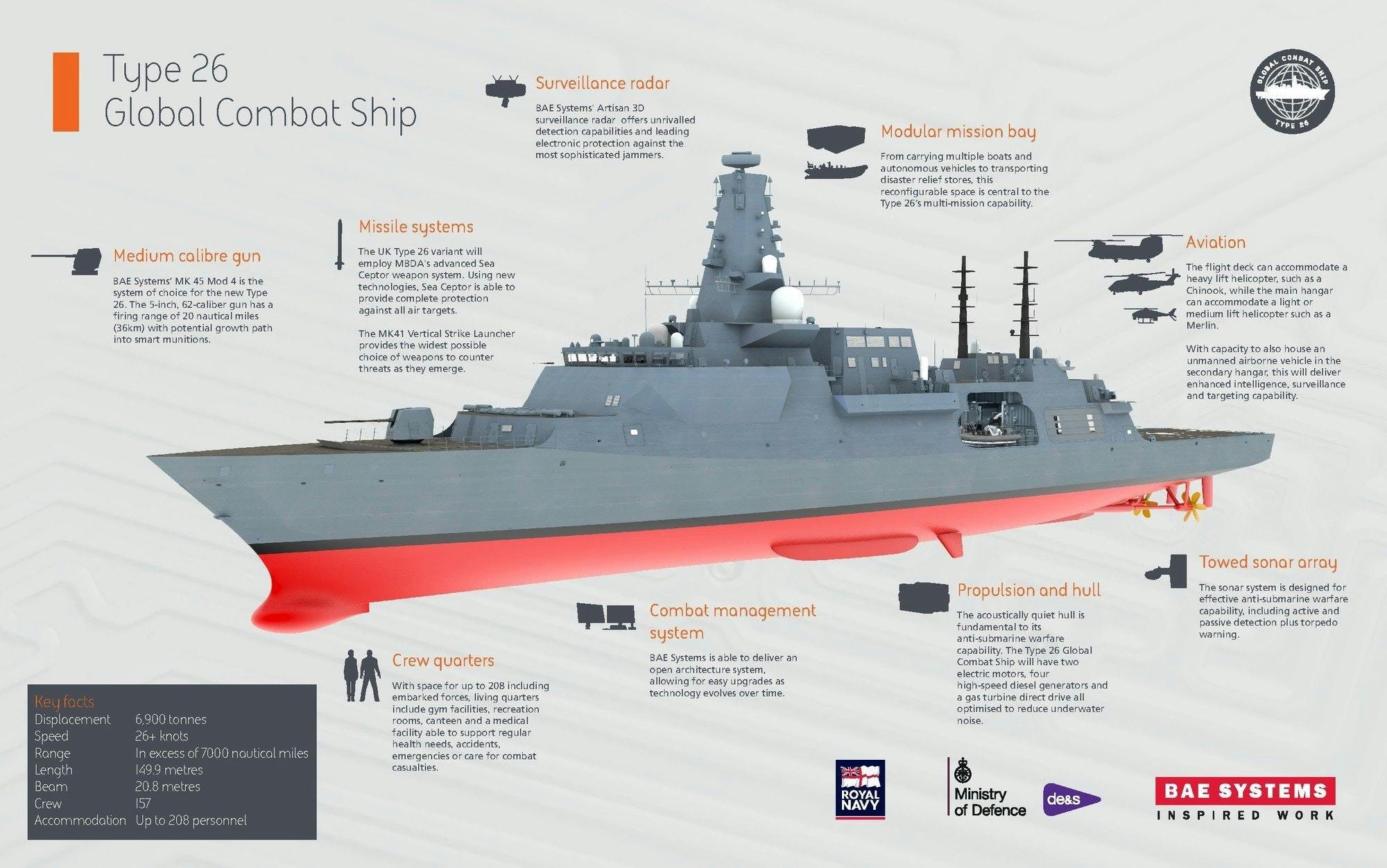
Originally planned to replace the Type 23 on a one-for-one basis, the 2015 Strategic Defence and Security Review (2015 SDSR) stated that only eight of the frigates would be built, not the originally planned thirteen. This decision was taken to reduce costs, as was the decision to delay the start of construction from late 2016 until 20 June 2017 when the build of HMS GLASGOW the first of three Batch 1 ships of the class commenced. Of the other two Batch 1 vessels HMS CARDIFF was laid down on 14 of August 2019 with construction of HMS BELFAST yet to commence. HMS EDINBURGH, HMS BIRMINGHAM, HMS SHEFFIELD, HMS NEWCASTLE and HMS LONDON will form Batch 2.
The total cost of the programme will amount to some £8B+.
Despite it being designed to replace the increasingly obsolescent Type 23, many of the weapons and systems on the Type 26 will have already been proven on the earlier vessel, notably the BAES Type997 Artisan (Advanced Radar Target Indication Situational Awareness and Navigation) 3D radar and the Sea Ceptor SAM. Also carried over are the Thales 2087 low frequency variable depth towed array sonar and the Ultra Electronics 2150 bow sonar. Each ship’s single Rolls Royce MT30 Gas Turbine is the same as that fitted to the Queen Elizabeth class carriers.
The BAES Outfit DNA(2)/CMS-1 Combat Management System (CMS) will also be a carry-over from both the Types 23 and 45. Likewise its helicopter, either the Leonardo Merlin HM2 or the Leonardo Wildcat HMA2 along with their attendant weapons will already have been in RN service for some time before HMS GLASGOW is commissioned in 2027. Whereas the equipment of the Type 45 was 80 per cent new, in the Type 26 only 20 per cent will be new.
This ensures that despite the £1B price tag per frigate costs are kept down by using proven technologies and equipment, and expenditure can be concentrated on aspects of the design to ensure that it is a generation ahead of offerings from other ship builders.
The claim by BAES that the Type 26 is the world’s most advanced anti-submarine frigate is largely based on noise reduction which is achieved by a mixture of engineering solutions building on knowledge gained via the Type 23 programme. These include hull shaping, internal pipework design and fixing equipment on shock and vibration-resistant mountings. Noise reduction has been achieved by mounting the MT90 gas turbine in an acoustic enclosure designed to minimise vibration and radiated noise. The Type 26 is powered by a Combined Diesel-Electric OR Gas Turbine (CODELOG) arrangement with four MTU 20-Cylinder 4000 M53B engines providing the diesel generator power. These are also contained in acoustic enclosures which are on mounts designed to isolate them from the frigate’s hull structure. Noise reduction is further aided by the aft two diesel generators being mounted above the waterline.
The vessels will carry the BAES 5 inch 127 mm L54 Mark 19 gun and will be fitted with a 24 cell strike-length Lockheed Martin Mk 41 VLSs which are sited forward of the bridge. The VLSs will make possible the carriage of the Raytheon Tomahawk Land Attack cruise Missile (TLAM), the Lockheed Martin RUM-139C Anti-Submarine ROCket (ASROC) and the Lockheed Martin AGM-158C Long-Range Anti-Ship Missile (LRASM). Other possible weapons will include the MBDA SCALP (Système de Croisière Autonome à Longue Portée – Long Range Standoff Cruise Missile) Naval (or MdCN Missile de Croisière Naval – naval cruise missile), or the Anglo-French MBDA CVS401 Perseus cruise missile currently under development. However, none of these weapons are currently in RN service and at this point there is no commitment to purchase any new munitions.
It may well be that the Type 26 enters service with the 5 inch gun, two Phalanx CIWS, twenty four Sea Ceptor missiles and the Thales Martlet, MBDA Sea Venom AShMs together with BAES Stingray torpedos carried by the on-board helicopters. With its primary role designated as an anti-submarine frigate it appears extraordinary that any attack on a submarine will be reliant on getting the ship’s helicopter aloft, something which cannot occur in extreme weather conditions. It is not fitted with the Magazine Launched Torpedo System (MLTS) carried on the Type 23s which would allow the frigate to fire Stingray anti-submarine torpedoes from an internal magazine.
By way of comparison the Franco-Italian FREMM (Frégate européenne multi-mission – European multi-purpose frigate) are equipped with B-515 launchers for the EuroTorp MU-90 torpedo while the Italian frigates are also equipped with the MBDA MILAS anti-submarine rocket system. The frigate also carries the NH90 anti-submarine helicopter which is also armed with the MU-90. Ironically in the 1970s and 80s RN ships were equipped with the Australian GAF Ikara ASW missile, generally accepted to be a superior weapons system to the ASROC.
While the Type 26 is primarily an anti-submarine frigate procuring single role vessels for the RN which is ever decreasing in size must be examined. In this respect the effectiveness of the vessel in the air defence role must be questioned. This may be compromised by the Artisan radar/Sea Ceptor missile combination. It is claimed by BAES that Artisan radar has a high level of resistance to jamming. Like the BAES SAMPSON radar it provides air surveillance, target identification and air traffic management services. Unlike the Type 45s which have a BAES S1850M dedicated air search radar, the Type 26 frigates must rely on Artisan for all surveillance and targeting functions.
The RN believes that this issue is offset by the Sea Ceptor missile system which requires no dedicated tracker/illuminator radars. The Mach 3 Sea Ceptor missile is cued by the ship’s target indication data and incorporates a datalink for mid-course guidance updates before it uses its own active seeker to guide it to its target. Artisan, like the SAMPSON radar, sits atop a tall mast giving it a good radar horizon and this feature is enhanced by the Sea Ceptor which does not require line-of-sight in order to engage its target. However, unlike SAMPSON which features two back-to-back planar arrays which rotate at 30 revolutions per minute (RPM) leaving no area of the sky without coverage for less than 0.5 seconds, Artisan rotates at 30 RPM which means that with its single array the radar picture is updated every two seconds.
Once detected the target’s position can be updated frequently on which basis it can create a tactical picture. Conversely, the effective radar range is limited because Artisan cannot stare in any one direction for very long it cannot put so much energy onto a target. The effectiveness of using a single mechanically scanned radar can also be compromised by how violently an incoming AShM manoeuvres. A lack of targeting information would also mean that Sea Ceptor must then rely on its own seeker which may then put the AShM dangerously close to the frigate.
In addition to the Sea Ceptor the other legacy weapon which will equip the Type 26 is the ubiquitous Phalanx CIWS. The continuing viability of the Phalanx to provide a ‘last ditch’ defence against incoming AShMs must be questioned considering its inauspicious combat record. Given its past failures in the face of relatively unsophisticated first and second generation AShMs the probability of it being effective against the latest generation of missiles is very low. To compensate for its growing obsolescence the US Navy has been augmenting the Phalanx by equipping its ships with the Raytheon RIM-116 Rolling Airframe Missile (RAM). Future US developments for short-range defence will possibly rely on the AN/SEQ-3 Laser Weapon System.
The UK equivalent is the MBDA Dragonfire laser directed energy weapon currently being developed by the Defence, Science and Technology Laboratory (Dstl). At this point laser weapons have proven to be capable of shooting down drones, though whether or not enough power can be generated by a ship for the laser to be capable of shooting down supersonic or hypersonic AShMs remains to be seen. The performance of lasers is also downgraded by bad weather and smoke, so at best such weapons would be complementary to gun/missile defences. All of this remains very much in the future, for the present however, the Phalanx as a weapons choice for the Type 26 signals no progression in ‘last ditch’ defence.

The June 2018 decision by Australia to purchase nine Type 26 frigates as the Hunter class could see the RN purchasing the same radar fit to be mounted on the Australian vessels, the CEAFAR 2 Active Phased Array Radar and CEAMOUNT Active Phased Array Illuminator. The CEAFAR/CEAMOUNT radar combination radically changes the size and design of the main mast with six diamond shaped arrays for each radar mounted on the mast. The radar will be integrated with the Lockheed Martin designed Aegis combat management system and Saab Australia 9LV tactical interface. CEAFAR employs a unique microwave tile-based design. The combination of the microwave tile and the Digital Beam Forming (DBF) backend provides the CEAFAR radar with the capability to perform simultaneous 360 degree 3D volume air search, surface search, fire control support and target classification in cluttered and jamming environments.
The CEAMOUNT radar provides target illumination and missile uplink simultaneously for multiple semi-active radar homing missiles and would probably not be purchased by RN with both the Aster and Sea Ceptor being active radar homing missiles. The CEAFAR/CEAMOUNT combination requires considerably more power than the Artisan, is heavier and takes up more space. Claims were made in the Australian press that the Type 26 would require a substantial redesign and the vessels would grow to 10,000 tonnes. These claims were subsequently denied by BAE Australia which suggest that the claim the original design had growth potential built in would appear correct. The total cost of the Australian programme is AUD$35B which reflects the far more sophisticated fit out of the Hunter class giving it a capability to provide area air defence and operate in conjunction with the RAN’s Hobart class destroyers via Cooperative Engagement Capability (CEC).
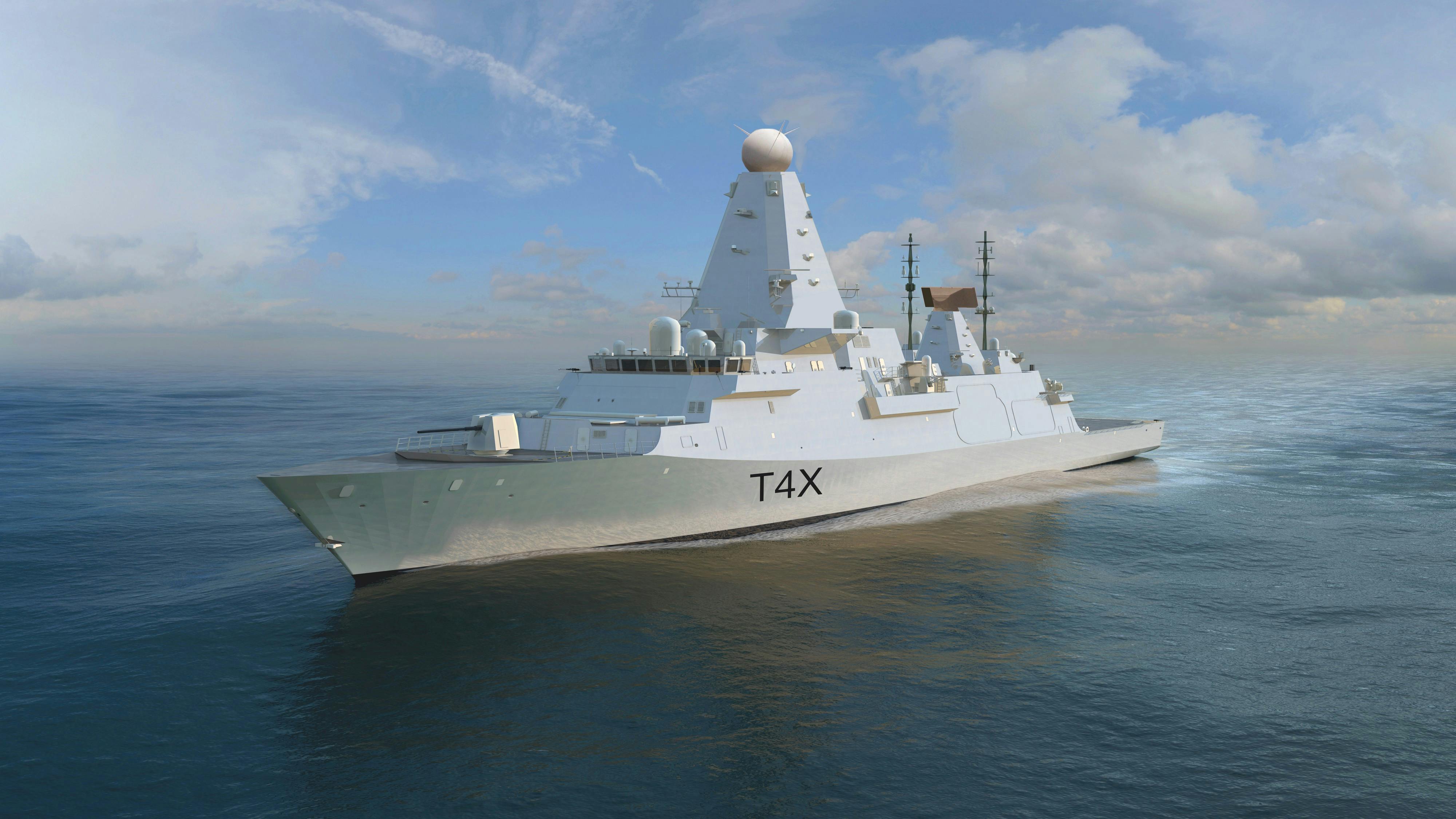
An alternative to the Australian radar could be to mount both the SAMPSON and S1850M radars on the Type 26 hull as proposed for the Type 4X destroyer. This would give the Type 26 area air defence capabilities equivalent to those of the Type 45s and make them more of a multi-role frigate rather than a single role ship. As with the Hunter class concerns have been raised with respect to the Type 26’s ability to be fitted with a large mast capable of mounting a SAMPSON radar with the commensurate increase in weight. These have been addressed in UK Defence Journal interview with Paul Sweeney, former MP for Glasgow North East and former shipbuilder. The possibility of building the Type 26s in different configurations delivers the possibility not only of an ongoing ‘drumbeat’ of construction but also economies of scale.
THE TYPE 31 FRIGATE
Announced as part of the 2015 SDSR, the Type 31 will comprise a class of five vessels, described as light frigates, replacing the cancelled Type 26 frigates. A contract for the ships was formally awarded to Babcock Group on 15 November 2019 for their Arrowhead 140 design. Based on the Danish Iver Huitfeldt class the Type 31 weighs 5,700 tonnes making them heavier than the Type 23, hence it is misleading to describe them as ‘light frigates’. Compared to the BAES 3,677 ton Leander design submitted in competition with the Arrowhead 140, the Babcock ship ensures greater growth potential for adding weapons and sensors in the future. Costing an average of £250M per vessel there is the possibility that more will be built and the RN’s surface fleet expanded.
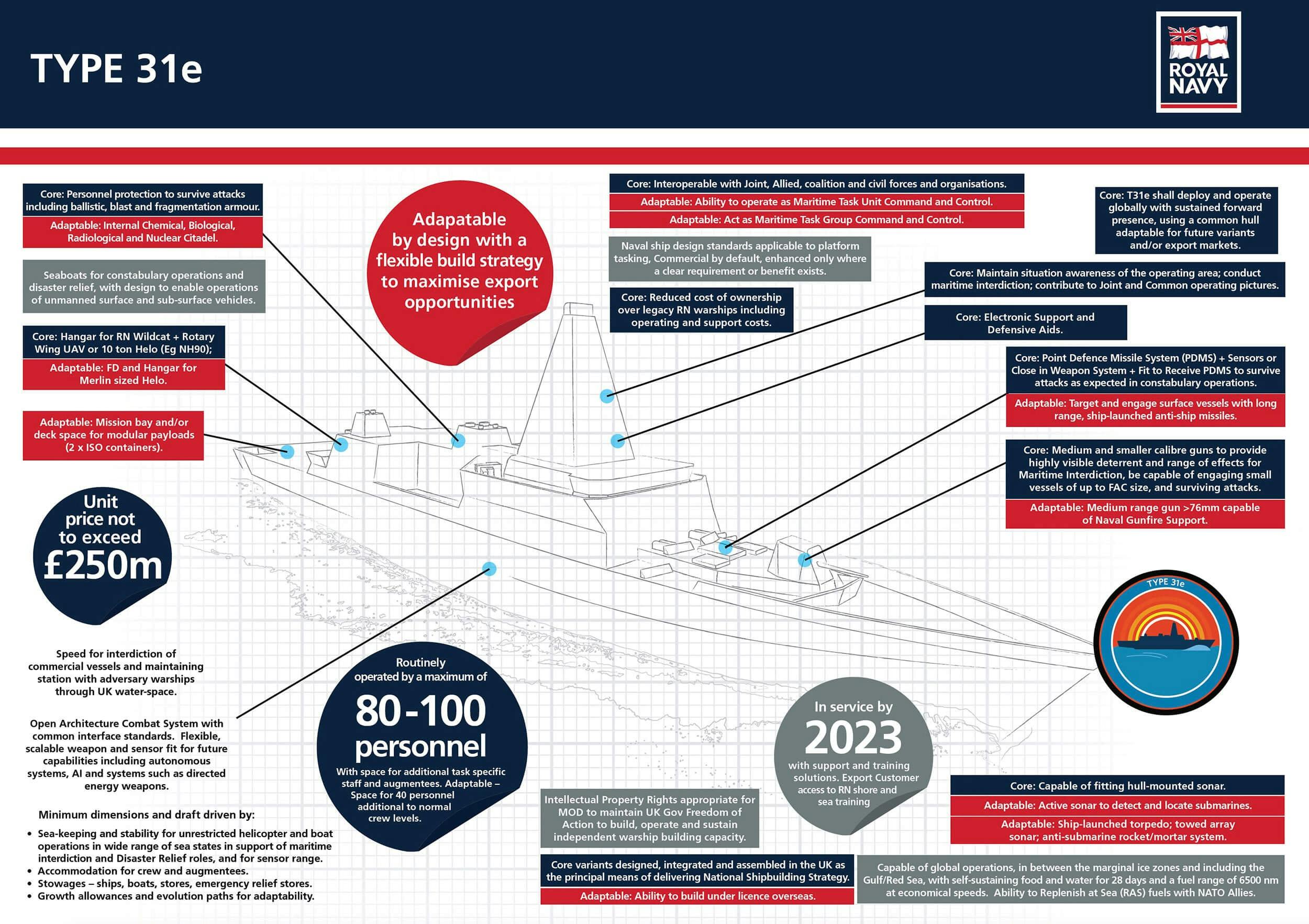
To keep the costs down it had been conjectured that the Type 31 would employ weapons and sensors transferred across from the Type 23s as each was decommissioned. It came as somewhat of a surprise when it was announced that the ships would be armed with one Bofors 57mm Mk110 and two Bofors 40mm Mk4 guns and use the Thales TACTICOS Baseline 2 combat management system (CMS) and the Thales NS110 AESA radar. These are found on no other RN ship. The Type 31s will also have a 24 cell VLS for Sea Ceptor missiles (although the latest illustrations show only 12 cells) and carry either a Wildcat or Merlin helicopter. The RN’s earlier experience with light frigates, the Type 21 Amazon class, were ill-equipped particularly with respect to anti-air weapons and consequently suffered two sinkings in the Falklands War.
The Type 31 in comparison will carry cutting edge weapons and sensors and prove far more survivable in a shooting war, especially when operating in concert with Type 45s and Type 26 where each type will provide complementary capabilities. Operating alone, they would prove useful in patrolling the Gulf, the Strait of Hormuz and on anti-piracy duties off Somalia. Moreover, the increasing deficit in RN personnel would be offset by building ships of this type which require smaller crews. The Type 23s require a crew of 185, the Type 31 in comparison will require 80-100 officers and ratings.
With the Type 31 contract being awarded to Babcock the UK will have two frigate designs in production simultaneously. Moreover, each design will be armed with different weapons and equipped with different radar systems which will be complementary to each other. The move away from a BAES monopoly on warship construction will ensure that going forward the RN will have access to a wider range of weapons and systems. A primary example of this is the decision to equip the Type 31s with the Thales NS110 AESA 4D E/F band dual axis two panel radar. The radar scans at a rate of 30rpm and simultaneously scans in azimuth and range. It has a maximum air search range of 152nm (280km) and can simultaneously track 1,000 targets.
An Identification Friend or Foe (IFF) interrogator antenna is integrated with the main radar as part of the multi-purpose platform. Also integrated are the: X-band Scout Mk3 frequency modulated continuous wave (FMCW) radar for low probability of intercept (LPI) and high resolution surface search; an IR-camera; the automatic identification system (AIS) for commercial ship tracking; and, Automatic Dependent Surveillance Broadcast (ADS-B) civil aircraft tracking antennas. Not as sophisticated as a radar with four flat panel arrays the NS110 is nevertheless scalable with the addition of transmit/receive (T/R) modules and as an AESA radar uses superior technology to the Artisan.
Without a medium-calibre gun the Type 31 will be incapable of providing NGS. Nevertheless, for its intended roles in low-medium intensity conflicts the frigate is very well equipped to provide air defence against aircraft, UAVs and AShMs and against surface threats posed by fast attack craft. The 40mm gun is arguably superior to the Phalanx as a CIWS by delivering a heavier weight of fire further away from the ship. The gun has a rate of fire of 300 rounds per minute (rpm) and has a maximum range of 7.8 miles (12.5km). The 57mm gun can fire up to 220 rounds per minute out to a range of 10.6 miles (17km). Both guns can fire the BAE FUZE Pre-fragmented, Programmable and Proximity-fused (3P) ammunition and can quickly switch to engage a range of air and surface targets.
The Mk110 can fire BAES Ordnance for Rapid Kill of Attack Craft (ORKA) projectile which is a one shot-one kill round fitted with an imaging semi-active seeker. It can be guided to its target through laser designation or autonomously by downloading an image of the target prior to firing.
In development is the US Defense Advanced Research Projects Agency’s (DARPA’s) Multi-Azimuth Defense Fast Intercept Round Engagement System (MAD-FIRES) point defence anti-missile missile which will be fired from the gun. When factors such as the rate of fire and the amount of explosive per shell into account the Bofors gun actually achieves a higher amount of explosive fired per second compared to the Leonardo 76mm gun.
The primary air defence weapon, the Sea Ceptor, combined with the two gun systems provides good protection against saturation attacks from the widest range of air threats short of hypersonic missiles.
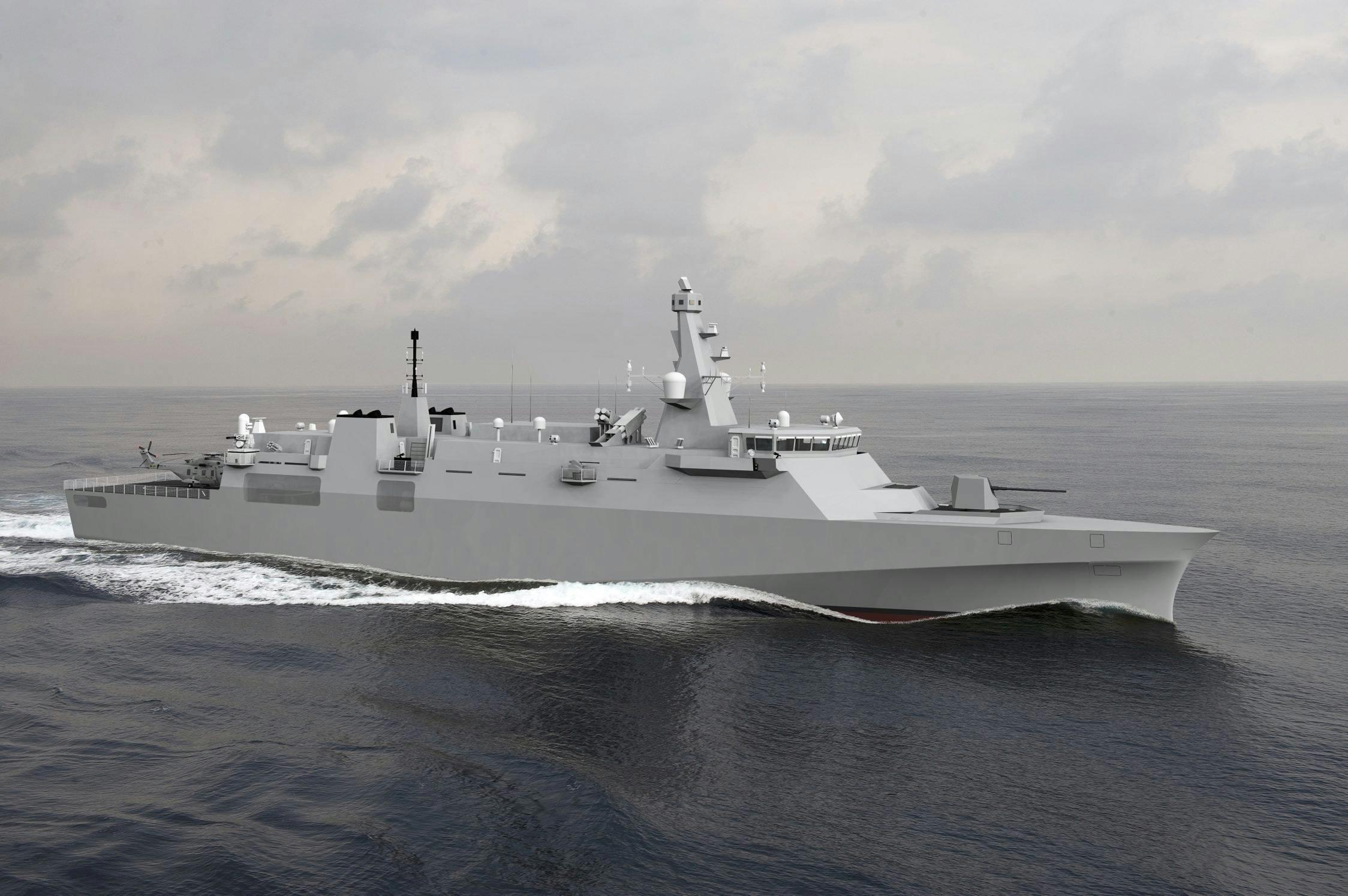
Propulsion will be provided by four MTU 20V 8000 M71 engines, each delivering over 8,000 kW in a Combined Diesel And Diesel (CODAD) arrangement. This is the same layout found in the Iver Huitfeldt class which does not make either type particularly well suited to an anti-submarine (ASW) role although care has been taken to reduce the acoustic signature. Nevertheless there is provision for mounting a sonar on the hull, and the Danish vessels do feature the Atlas ASO 94 hull mounted sonar.
The Iver Huitfeldt class also mount four launchers for MU-90 ASW torpedoes, a feature also lacking on the Type 31. This reflects the reality that the Danish vessels are designed to perform a wider variety of roles than the Type 31 as demonstrated by their ability to carry thirty-two Raytheon SM-2 IIIA SAMs in Mk 41 VLSs, twenty-four RIM-162 Evolved Sea Sparrow Missiles (ESSMs) in Mk 56 VLSs, and eight to sixteen Boeing Harpoon Block II AShMs.
This indicates the possibility for growth in the future for the Type 31 thanks to the modular design of the ship permitting an increase in top weight, something which has inhibited adding weapons to previous RN ships. (Witness the inability to add Phalanx CIWS to the Type 42s without removing the ship’s boats.) The Type 31 has a large flight deck and hangar, plus flexible mission bays amidships offering future growth potential.
What is not clear at this point is if the Type 31s are going to use some form of the StanFlex modular mission payload system as found on the Danish vessels. Such a system would greatly enhance the flexibility of the design and permit the addition of additional weapons with greater straightforwardness.
FUTURE POSSIBILITIES
Like the Type 26 the Type 31 will go to sea with a minimal weapons fit particularly with respect to ship-launched ASW weapons, long-range SAMs, land-attack cruise missiles (LACMs) and AShMs despite both vessels having the ability to be so equipped. Both designs feature mission bays which provide the possibility that the frigates will carry unmanned surface vehicles (USVs). The RN has already carried out successful trials with the Elbit Systems UK Seagull USV.
The Seagull has multi-mission capability, being able to perform ASW, Mine Counter Measures (MCM), Electronic Warfare (EW), Maritime Security (MS), Hydrography and other missions. Two vessels can be controlled from the same MCS (Mission Control System) and the Seagull is capable of both manned and unmanned modes of operation. Employing USVs for a wide range of missions will provide a force multiplier for the host vessel. The problem remains that neither the Type 26 nor 31 will carry on-board ASW weapons.
Prospectively to be announced in the upcoming 2021 Integrated Review of Security, Defence, Development and Foreign Policy is a decision on the Interim Surface to Surface Guided Weapon (I-SSGW) requirement which will be purchased to arm the eight towed-array sonar equipped Type 23s. The possibilities to fulfil this requirement are the Lockheed Martin Long Range Anti-Ship Missile (LRASM), the Kongsberg Naval Strike Missile (NSM) and the Saab RBS15 Mk 4 ‘Gungnir’ (Odin’s Spear). These will undoubtedly transferred to the Type 26s as each Type 23 leaves service.
With no prospect of additional AShMs being available, the Type 31s will rely on Wildcat helicopters armed with Martlet and Sea Venom missiles to provide an anti-ship capability. Here the same problem exists as with ASW weapons; if the helicopter is not airborne the frigate effectively possesses no ant-ship capabilities. In the Gulf where the greatest surface danger comes from Iranian fast attack craft a combination of the Type 31’s 57mm and 40mm guns and the missile equipped Wildcats are particularly well suited to counter such a threat. However, initially there are no plans to equip the frigates with heavier AShMs, undoubtedly because of cost.
A possible answer to this dilemma could come by retaining the Harpoon Block 1C missiles currently arming the Type 23s and due to be retired from service in 2023. Rather than retiring their stocks of the Block 1C the USN is modifying and upgrading the missiles to Block II+ which features an improved GPS guidance kit and a networked enabled data link that enables the missile to receive in-flight targeting updates. At a cost of USD$240,000 (£185,000) per round this is a very cost-effective solution for providing long range anti-shipping strike and land attack. This solution makes further sense if the Boeing Poseidon MRA1 aircraft are armed with the air-launched version of the Harpoon.
CONCLUSION
The Royal Navy has wisely chosen two designs which are considerably larger than any frigates which have preceded them. There is ample space in both designs for future growth should decisions be made to either update or add additional weapons and sensors.
Indeed this will prove necessary throughout the life of the ships as the type and lethality of threats grow. Unfortunately, as demonstrated with the Type 45 where Mk 41 VLSs have not been fitted to the ships, despite space specifically in place for them, under-investment in both the Type 26 and Type 31 will see their potential limited.
At a time when there is an increasing threat from a resurgent Russian Navy to not see the ships developed to their full potential would be negligent.
References
Powering the stealthy submarine hunter – Type 26 frigate propulsion system in focus, Save the Royal Navy, accessed 12 September 2020, <https://www.savetheroyalnavy.org/powering-the-stealthy-submarine-hunter-type-26-frigate-propulsion-system-in-focus/>.
Will the Type 26 frigate deliver a punch commensurate with its price tag? Save the Royal Navy, accessed 11 September 2020, <https://www.savetheroyalnavy.org/will-the-type-26-frigate-deliver-a-punch-commensurate-with-its-price-tag/>.
Norman Friedman, Australian frigate decision analysed, Australian Naval Institute, accessed 10 September 2020, <https://navalinstitute.com.au/australian-frigate-decision-analysed/>.
See my earlier commentary on the failures of the Phalanx CIWS: Kelvin Curnow, Improving the Type 45 Destroyer, UK Defence Journal, accessed 11 September 2020, <https://ukdefencejournal.org.uk/improving-the-type-45-destroyer/>.
George Allison, Feasibility study looking at fitting Australian CEAFAR radar on future British ships to be launched, UK Defence Journal, accessed 11 September, <https://ukdefencejournal.org.uk/feasibility-study-looking-fitting-australian-ceafar-radar-future-british-ships-launched/>.
Stephen Kuper, BAE sets the record straight on Hunter Class concerns, Defence Connect, accessed 12 September 2020, <https://www.defenceconnect.com.au/maritime-antisub/6356-bae-sets-the-record-straight-on-hunter-class-concerns>.
George Allison, The Type 4X Destroyer – An early look at an early concept, UK Defence Journal, accessed 22 September 2020, <https://ukdefencejournal.org.uk/the-type-4x-destroyer-an-early-look-at-an-early-concept/>.
<https://www.thalesgroup.com/sites/default/files/database/document/2019-11/NS100-V04.pdf>.
Jed Cawthorn, Type 31 Light Frigate – Weapons options, UK Land Power, accessed 18 September 2020, <https://uklandpower.com/2019/09/19/type-31e-light-frigate-weapons-options/>.
French Navy FTI Frigate: From 57mm to 127mm, Naval Gun System Choice Still Open, Navy Recognition, accessed 23 September 2020, <http://navyrecognition.com/index.php/news/naval-exhibitions/euronaval-2016/4535-french-navy-fti-frigate-from-57mm-to-127mm-naval-gun-system-choice-still-open.html>.
According to the RAF website the aircraft are to be initially armed with US weapons without specific reference to the type of munition. <https://www.raf.mod.uk/aircraft/poseidon-mra1/>.



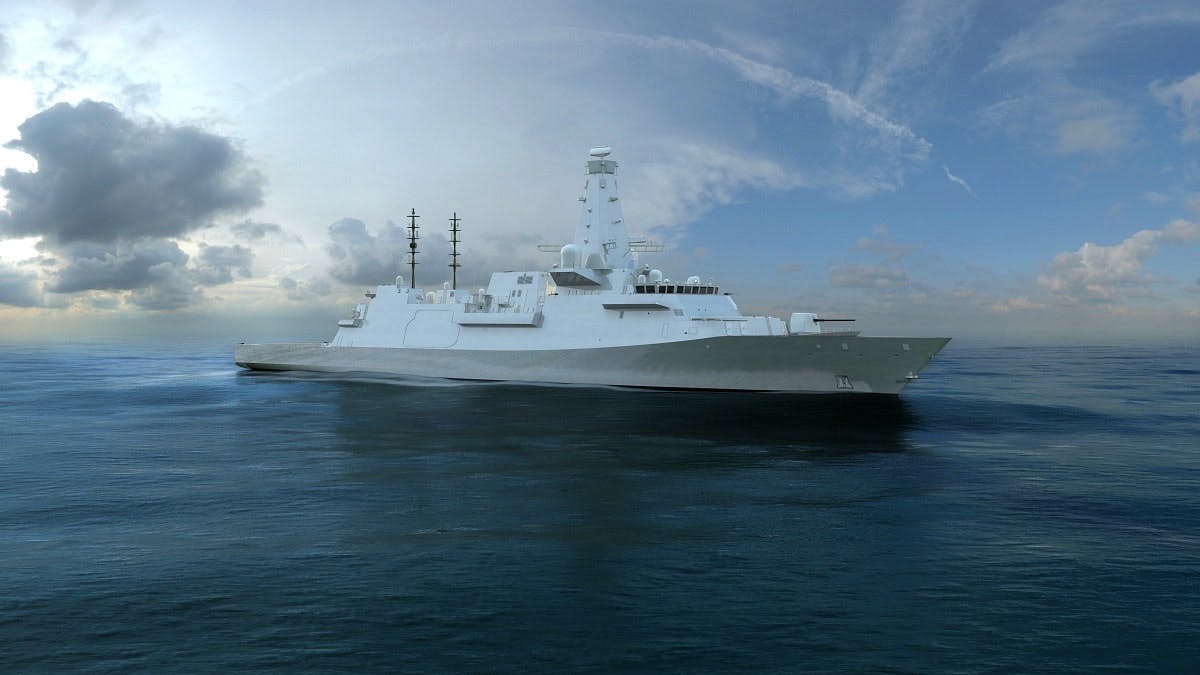
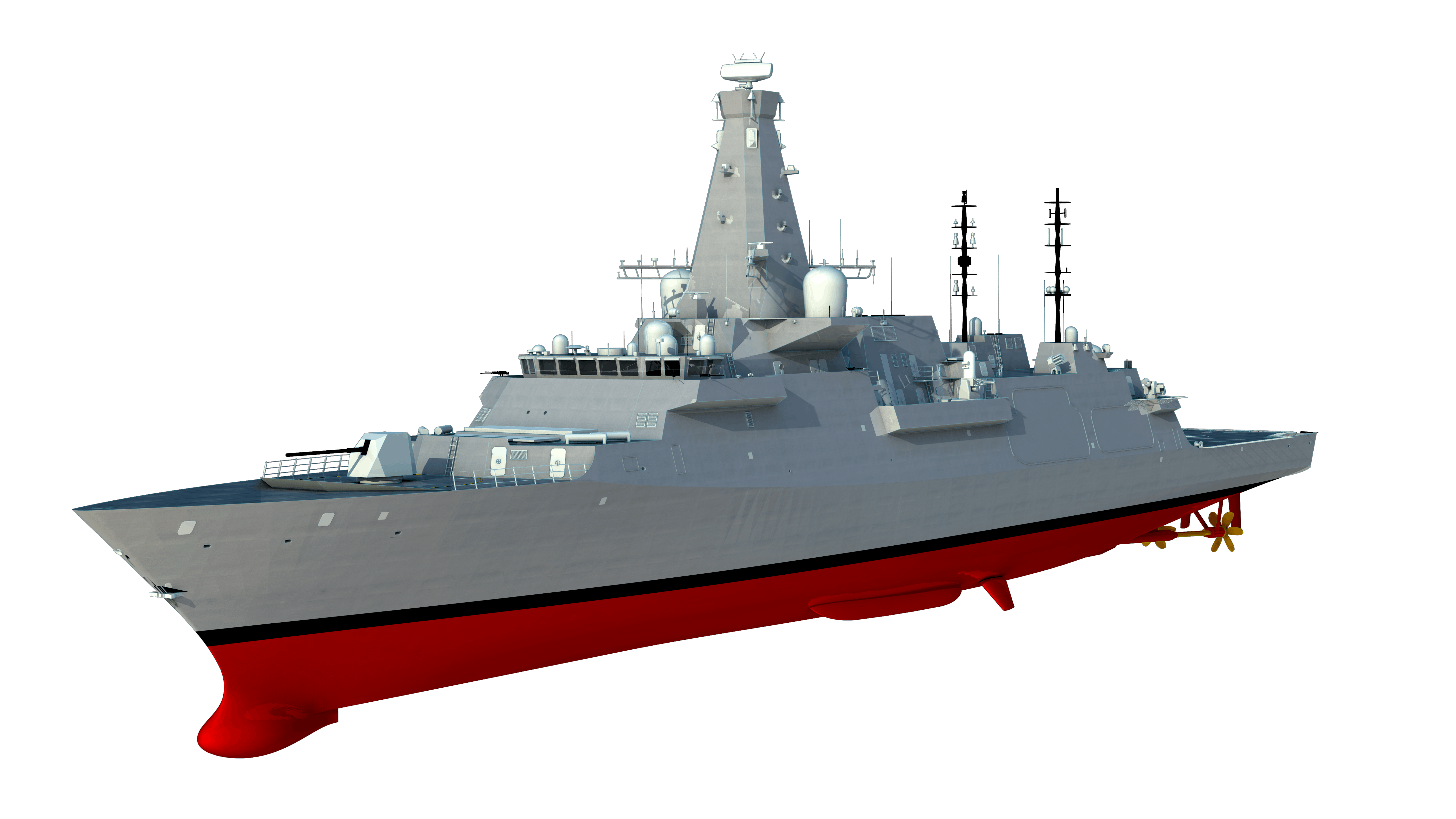
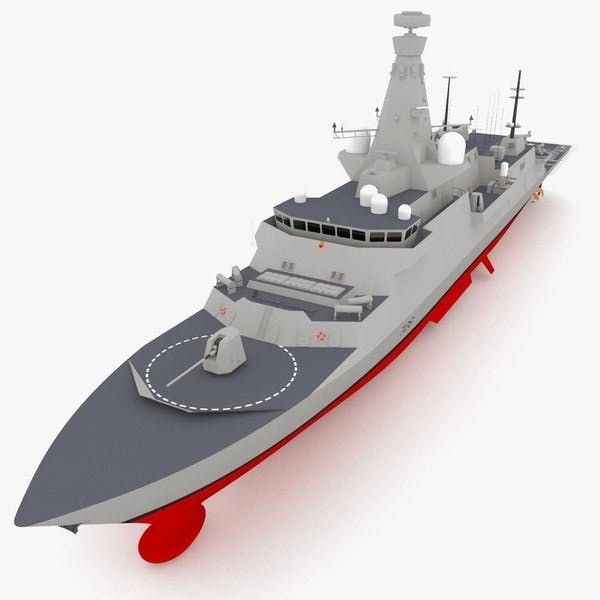
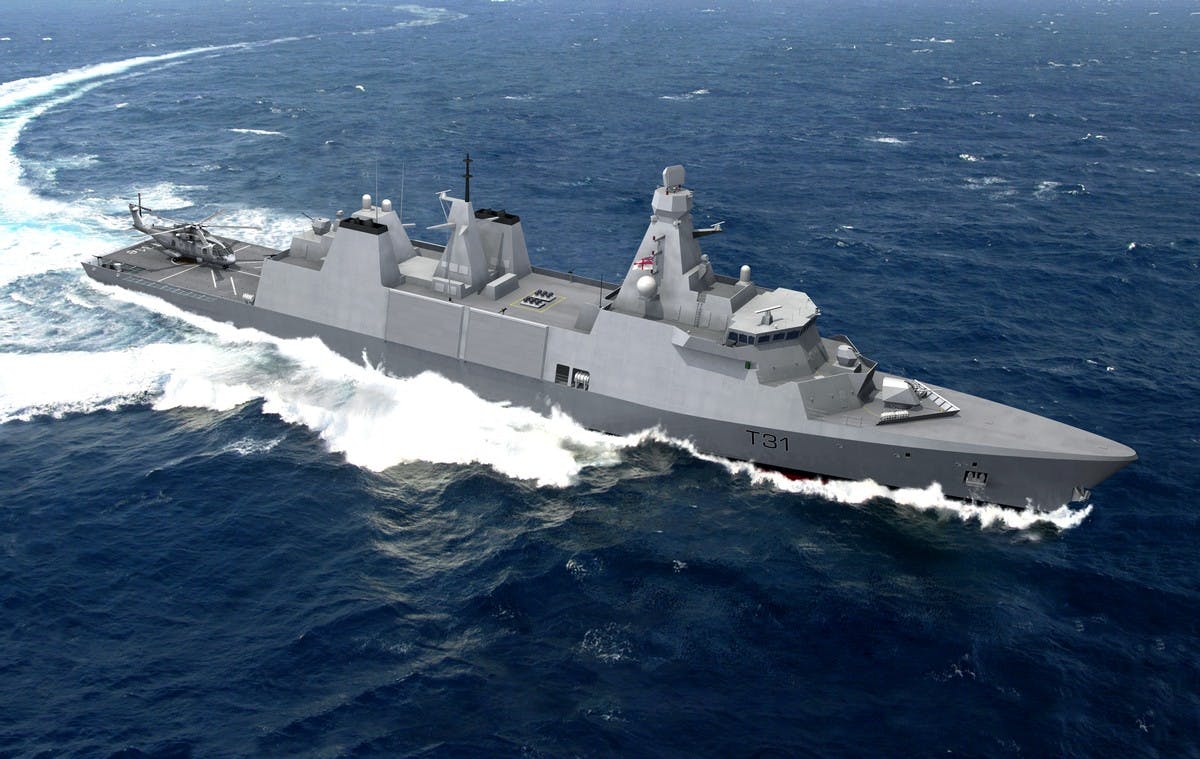
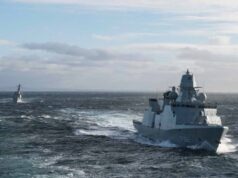
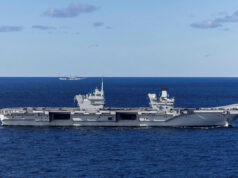
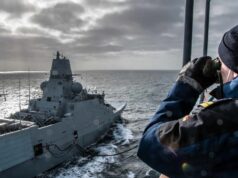
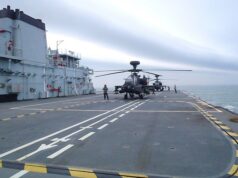
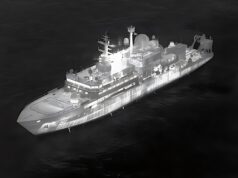

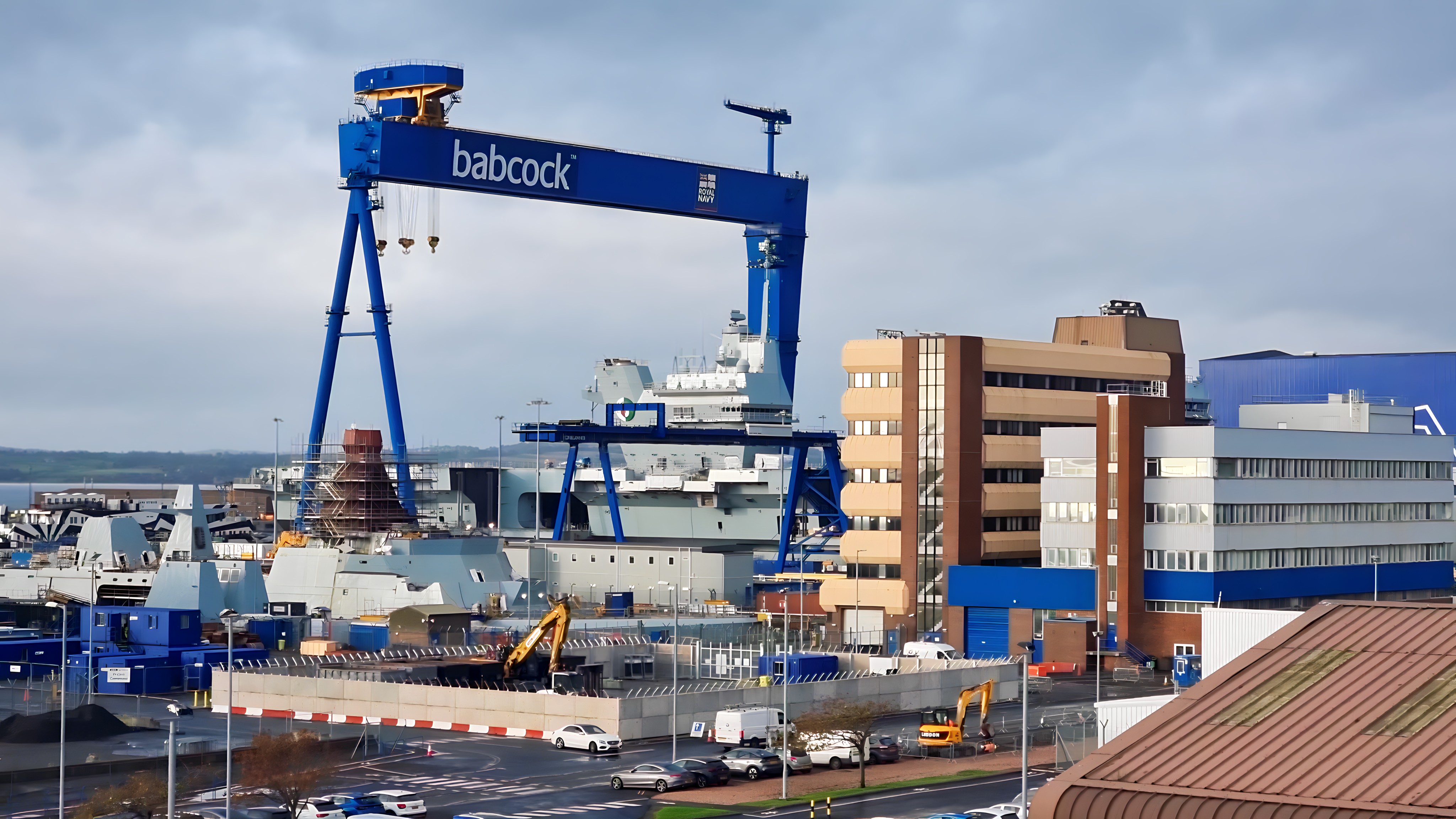
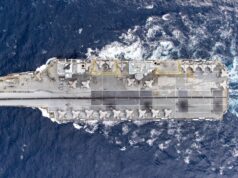

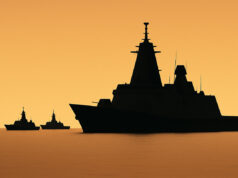

Excellent post ??????????? Hopefully they get the armament they deserve. Reductions in crew size costs can only be a good thing . More ships manned and at sea simultaneously ?? . Impressive ships ????
Most of the times a ship has been hit with an ASM the Phalanx system has been turned off. Hard to shoot down a missile when the system isn’t turned on.
The problem is when switched on phalanx has a tendency to gun down anything the moves. Which is complicated if you’re near friendly forces or your not expecting an attack in piece time.
This happened with the first Gulf War, ships firing chaff, the Phalanx decided to engage the chaff rather than the Silkworm missiles fired at them
Just goes to show how obsolete Phalanx is becoming. 20mm rounds don’t have the stopping power to destroy faster and faster anti ship missiles.
Phalanx doesn’t shoot 20mm projectiles, but saboted 12.7mm rounds I believe. Even less stopping power apart from the high volume hopefully hitting the target.
No it actually does shoot 20mm. That said the problem with phalanx isn’t so much calibre size but rather range and accuracy. At speeds of missiles these days the shrapnel alone can still hit the ship and effect a mission kill.
No it shoots 20mm orange plastic sabots that contain a tungsten penetrator. The sabots peel off and go everywhere and the tungsten penetrator goes on its merry way to the target.
Being a kinetic kill mechanism it’s potential energy converting to kinetic energy does the damage.
Missiles even early Soviet examples such as the 1950/60s era vintage SSN3 Shadock where never going to be stopped dead. SHADOCK had a forward firing shrapnel warhead that projected shrapnel out in a cone in front of the missile when the warhead detonated. The idea is to make the missile aero dynamically unstable by putting holes in them or hitting control surfaces and getting the thing to miss. The faster a missile flies the easier it will rip itself apart if it becomes unstable.
Rubbish.
The phalanx round is a kinetic kill round. If it hits a target the conversion of potential energy to kinetic energy is a factor of the target speed plus the rounds speed.
The faster the target the more potential energy converted to kinetic energy.
Unless the laws of physics have suddenly changed that is….
It’s a transfer of momentum. A higher calibre round will have a greater mass and thus a greater stopping power when it collides with an incoming missile.
While 20mm phalanx rounds may destroy the missile’s seeker, they have neither the range nor kinetic energy to stop a Mach 4 missile doing some serious damage hurtling towards a ship.
That’s not what its designed to do.
The 20mm Sabot and aluminium pusher allow you to have a 20mm cartridge shove a 15mm heavy penetrator out of the barrel with the same MV that a 20mm cartridge imparts. The disadvantage is all those sabots and aluminium pushers end up flying off in all directions covering the upper deck in debris. The aluminium pushers are especially bad as they can do serious damage if the Phalanx is firing across a deck. Helos, Aircraft and people are especially vulnerable.
If the penetrator hits the target anywhere i.e. seeker, wings or airframe its either going to knock a hole in it or damage it . The missiles speed then starts to do the work for you. With the loss of aerodynamic surfaces or holes in the body the missile will rip itself apart and (hopefully) ditch/miss.
Slight correction: The MBDA Perseus was just a concept. It never progressed. The FCASW is currently 2 diiferent missiles. 1 Supersonic, 1 Subsonic Stealthy. The French favour the supersonic, the UK the subsonic. It’s not clear which one will progress to production, or if the competing demands will actually lead to cancellation of the programme. The ideal would be both types..
I’ve said it before, but Mk.41 is a mistake. Once we allowed Type 45 and Aster to go down the Sylver route we should have committed exclusively to that. Having 2 types of VL is symptomatic of the decisions being driven by muddled thinking and desperation within the MoD. Mk.41 would have been a better choice for Aster than Sylver (we could have even made our own version of Mk.41 like the South Koreans have if we were really precious..). But the decision was made and we are where we are.
So what is the point of Mk.41??
The solution is of course that we should just stick with Sylver now. Re-life the Harpoon to get us to as close to FCASW as possible, maybe buy a very small quantity of NSM which could be added to the T31 later as T41 and T26 get FCASW. But thats it. Then go all in on FCASW. Sorts out anti-shipping and long range strike. Then get MBDA to fit some surplus Stingray on the box launched MILAS missile, which has double the range, and forget about obsolete ASROC.
We could even re-use the recently re-furnished MTLS on T26, after all killing USV’s or hardkill torpedo defences would then be an option…
The desire to have ‘shiny’ Mk.41 really is totally unexplainable..people need to remember that T26 and T31 are only going to be operational in 2030. That’s 10 years away. In those 10 years ASROC and TLAM will only get increasingly obsolete….
I’ll disagree on your Mk41 position. Sylver locks the UK into a narrow missile selection, Mk41 at least opens up the option for US missile use in future, or from anyone else that decides to get into the missile business.
As you say ASROC and TLAM are dated platforms, FCASW is the preferred option over LRASM but what if the FCASW project crashes and burns, or takes forever, what then? Likewise Aster BMD would be the likely preferred option, but those programs already significantly lag the US SM-6 and SM-3 programs. What happens if they fail to live up to expectations? Even if all that doesn’t come to pass, the UK at least has a commercial negotiating position to try to control costs.
There is also a strong commercial incentive for MBDA to support Mk41 qualification if they ever hope to sell into navies using that platform, like Japan, Germany, Netherlands, Norway, Spain, Australia, Canada, Denmark, S. Korea, etc etc. MBDA might even decide its worth while developing a “universal” ASROC solution that can take MU90, Mark 54, Sting Ray and perhaps others, once again opening up a world market and help cement their MU90 market penetration.
I suggest that the first missile the UK will qualify for Mk41 will be Aster. The reason is that in combination with CEC, which has to be on the RN’s to-do list, it provides a major uplift in CSG defence, without having to put an expensive radar on T26. Also no reason to add Mk41 to T45 in this scenario. Then T45 replacement migrates to Mk41, so we have a single VLS type across the fleet.
I know we’ve discussed this before, and you make a very strong point. But I have to fall on the side of Sylver too.
Sylver “locks us” into a relatively narrow but increasing range of missiles, some of which we currently operate (Aster 15 and 30, CAMM) or are actively working on bringing into service (FCASW). That covers our stated current and planned inventory for AAW at all ranges, BMD (if it becomes a mission, Aster 30NT is a stated interest of the RN), ASuW and land attack. We have no stated plans to introduce any weapon in the Mk41 “stable” at all.
To me, Mk41 is a hedge against one of the few real European collaboration success stories- advanced missile systems. I say that from the perspective that (as far as I’m aware) there really haven’t been the hissy fits, workshare arguments, pullouts from deals etc. that have marked most other major collaborations. They’ve also produced excellent systems which are a match for US ones in pretty much every case. Why would we expect them to fail, when so far we’ve succeeded with Aster, CAMM, ASRAAM, Meteor, Brimstone, Storm Shadow/Scalp, and those are just the ones I can think of that we operate. I believe that France and Italy also use other systems that are Euro projects that we also have product share in (CAMM-ER for instance).
You make a fair point about the increased sales opportunities for MBDA that Mk41 provides, but those countries you list are already wedded to the US combat systems and software- not just the launch hardware. The’d have to integrate Aster with AEGIS, etc, for their products to have a chance in those markets. I just don’t see them making that decision. By the same metric, we’re never going to get SM-3 or -6 because integrating that into Sea Viper just to get BMD would be wildly expensive.
We have skin in the game when it comes to MBDA’s missiles and the existing combat systems (including Sylver) that we have in service, I really don’t understand why we’ve moved away from it with the T26. I would love the RN to explain their thinking, and I don’t see why they don’t. The USN and other western navies very publicly state where they intend to be going when it comes to future armaments, while pretty much everything our entire MOD does is shrouded in either secrecy or just a complete lack of communication- whether the circumstances require it or not.
Hi Joe. Let me try to address some of your points. At the outset we should separate the VLS from the missiles. Moving to Mk41 is insurance. If the insurance isn’t needed then we can exclusively operate European missiles from Mk41, if we choose. But Mk41 is also an opportunity to adopt, if we choose, from whatever the US develops over the next decades, since they are willing to throw a lot more resources into the field than Europe will.
It would be wasteful to use expensive hot launch capable VLS for cold launch CAMM. Especially Mk41 or Sylver A-70 strike length cell versions. Being able to quad pack doesn’t mean its a good idea if we have lower cost options, which we do in T26.
I hope for a successful FCASW outcome with either sub-sonic stealthy or supersonic variants, or both. But hope isn’t a strategy. What happens if only one of the variants is developed and we find a need in future for the other? Currently the French favour supersonic while the UK favours sub-sonic, what happens if we cannot reconcile that?
Mk41 is a hedge against a failure to deliver by MBDA, not against the programs. Its perfectly possible to want and expect MBDA to deliver while being prudent in the name of defence. It also helps keep both US MIC and European MIC honest. Aster is a success story and frankly, had it been qualified on Mk41 much earlier it might have won business away from semi-active ESSM and SM2 missiles. It may be too late now as both are getting active seekers. FCASW though could be a major success for MBDA in Mk41 as it could be in advance of what the US are doing, at least based on public announcements. As far as I’ve seen CAMM-ER is Italy only at this time.
Not all Mk41 systems use Aegis. The Danes, the Germans and the Japanese Hyuga class use Tacticos. IIRC the Dutch use a domestic CMS. The Canadians IIRC use a domestic CMS that may leverage some of the Aegis modules. But yes others such as Spain, Australia and Norway use Aegis. Note, that I am not assuming MBDA will sell into the US. Best possible outcome there would be a license deal. What is certain is that if MBDA fail to qualify for Mk41 they will be guaranteed not to sell to Mk41 based customers. Generally not a good idea in sales to lock yourself out of markets.
Now, with respect, saying we will never get SM-6 or SM-3 because of integration costs is your assumption. The Dutch have been considering SM-3 for a while. BMD is eye wateringly expensive in per missile costs whichever path we go. “Just to get BMD” is really underestimating the future threat of hypersonic weapons, whether following ballistic trajectory or maneuvering boost-glide or scramjet based. Its the threat of hypersonics that is driving strategy changes very publicly in the USN and USMC.
To say we have skin in the game with MBDA needs qualification. With systems and equipment already in use – sure. But Sylver is only the launch system, not the CMS or the missiles. BAES certainly does have a stake in MBDA. But do we have any IP or any manufacturing content in Aster for example? Aster is a Eurosam project involving MBDA France, MBDA Italy and Thales. However, even without UK content I would still advocate for UK use of Aster at this time and hopefully with future developments.
So the TL;DR version of all that would be – insurance as a prudent approach to defence, with a broader range of potential future options 😉
I love reading discussions like this. Educational and thought provoking
I can understand some of your reasoning. But I disagree with the conclusions. Allow me to explain why:
Mk.41 has been in service since 1985. Thats 35 years of service. In military terms thats a lifetime.
To date there have been 9 US weapons integrated with it. Only 7 of those munitions are still in production or not obsolete. And 2 of those 7 are on the cusp of obsolesence. To date there are 0 non-US weapons integrated with Mk.41. And given the time it takes to integrate we can safely say that Mk.41 will reach at least 40 years of service without any non-US weapon capable of using it.
If thats not a clear direction of travel..I don’t know what is.
Mk.41 is in use by 15 nations (excluding NZ who are removing theirs and the UK where they are not yet in service). South Korea has developed its own VLS (K-VLS) so will depart the list in the future. A number of these nations only operate Mk.41 as a consequence of purchasing second hand vessels as well.
In comparison Sylver has been in service for 20 years and has 5 munitions integrated with 1 more on the way (CAMM-ER, which also gives a straightforward integration path for CAMM/Sea Ceptor). The development of the 2 new Aster variants will add another 2 missiles to the list. So there is a clear pathway to 9 munitions using Sylver.
Sylver is in service with 8 Navies, with a further 2 Navies about to join the club with ships using Sylver under construction.
So Sylver has achieved a lot in the last 20 years. Arguably a lot more than Mk.41 did in its first 20 years.
When you look at the list of Mk.41 users there are a number of nations that are clear US allies that will not stop using US weapons and Mk.41 (Japan, Australia and AEGIS users). Then there is Turkey, which is developing sovereign capability and also in the US bad books at present. Excluding a couple of secondhand ship users what then becomes apparent is that practically all the major users of Mk.41 are European nations…the majority of whom are ripe to be pulled into the MBDA/Sylver orbit as European defence co-operation becomes more pressing in the future.
So in answer to your points individually:
Thanks for the detailed response, let’s see if I can do it justice.
The history you outline doesn’t seem to be especially relevant, given that 5-6 years into the Mk41 35 year life we had an end to the cold war, so perceived threats, and particularly naval threats, were greatly reduced for at least 15-20 years and arguably longer. Certainly there was no great imperative or driver for new naval weapons development. The Harpoon is a good example of how the USN didn’t see a need to continue to develop and improve ASMs.
In some ways its not surprising. Consider how naval dynamics have now changed. The Soviet fleet largely went away and even today Russia’s surface fleet is not a primary threat. It’s the Chinese fleet that’s building into a much more serious challenge to the USN, in combination with Chinese political actions in and around the SCS, which is now driving weapons programs, and that’s a relatively recent phenomena.
Comparing how many weapons are qualified for each VLS isn’t really relevant wrt the UK. For example you indicate 5 munitions integrated with Sylver. If these are Mica VL, Crotale VL, Aster 15, Aster 30 and Scalp, then only Aster 15/30 are of interest to the UK and arguably only Aster 30, because Aster 15 functionality may be addressed by CAMM/CAMM-ER fired from dedicated low cost cold launch cells on T26.
I acknowledge, the same is also largely true for Mk41. The UK has no interest in ESSM, SM2, ASROC and Tomahawk, regardless of recent upgrades. If the Aster program delivers the Bk1 NT and Bk 2 BMD then its probable that the UK has no interest in SM-6 or SM-3. But that’s still a big “IF”. There is clearly program risk for a challenging project that now has to address maneuvering hypersonic targets, on what is becoming a critical capability for naval defence. The US SM-3 program has also had its challenges, so the program risks shouldn’t be underestimated IMO. Mk41 is important insurance for this. There is more to integration than just the VLS but starting with a missile already qual’d in the launcher makes it easier. What is certainly true is that the UK has no need for any Mk41 missiles until the first T26 is operational and available to help qual. missiles, late this decade.
The same point is true for a modern VLS launched land attack/ASM. FCASW is the preferred UK path, but if the program fails to deliver on what is needed for any reason, then the US may have either the current LRASM available, or more likely a new weapon in similar timeframe to FCASW. The JSM may provide another Mk41 option, albeit a different class of weapon.
The issue with relying on canister launching as an option may be deck space on T26, if we need to box launch both ASM and MILAS for example. Or add deck launched land attack, if the ASM either doesn’t support it or it doesn’t provide the range or warhead options.
We’ll doubtless disagree on this, but since the primary role for T26 will be in a CSG escort then its certainly valid for it to carry missiles that can be targeted by T45. The BMD exercises have already demonstrated this, using Dutch and US ships which weren’t using CEC, or operating in the same area of sea.
Is Aster 30 only a marginal improvement on CAMM-ER? MBDA used to publish >120km range for Aster 30 and >45km range for CAMM-ER. Even 2x the quoted CAMM-ER range would still be significantly less. The T26 Artisan could certainly support Aster 30 independently of T45. And if we are committed to the the Aster platform then it seems likely we would be buying more to support more ships capable of launching them, regardless of adding Bk1 NT or Bk2 BMD options.
I don’t see how hope has any relevance to qual’ing weapons in Mk41? When we put a Mk41 into T26 then we will need the CMS to support weapons it hosts, I assume BAES is capable of doing that. Lockheed already advertise a willingness to support non-US missiles in Mk41 – “Future missile integration could include … Common Anti Air Modular Missile (CAMM), ASTER, Future Cruise/Anti-Ship Weapon (FC/ASW) and Barak.” So then the final part is for the UK to ensure that FCASW is compatible and for Eurosams to ensure Aster compatibility with strike length Mk41.
Just because Mk41 doesn’t have a history of supporting foreign missiles doesn’t mean there is any inherent reason it cannot be done affordably and efficiently.
We van certainly agree not to waste either Sylver or Mk41 cells on CAMM though, in order to use them for other purposes.
Interesting and helpful discussion, thanks a lot.
One small comment and a question:
A comment:
> To date there are 0 non-US weapons integrated with Mk.41.
JMSDF Type-07ASROC is integrated into Mk.41 VLS. Very minor contribution, though. New SAM, based on AAM-4 technology “is planned to” be integrated into Mk.41 VLS “by 2023”, but surely not yet.
A question: Sylver VLS says it “can” fire VT-1 as well as TLAM, and SM-2 Blk4, but I could not find any trial information. I understand they are all still a paper plan? CAMM is also nominated, but never tested. I understand this means “not integrated” yet.
CAMM is integrated into ExLS in stand-alone version (and I guess Canada will be using it), but Mk.41-VLS-internal-version of ExLS does not exist, to date. CAMM on Mk.41 VLS is a bit more “nearer to come true” than CAMM on Sylver VLS, if judged only from press releases, but both are still not existing yet.
Thanks GHF, as always I learn things I didn’t know from you! I thought most of the Mk41 users were AEGIS too, so glad to be corrected on that front. Your arguments do make Mk4 a lot more viable in my opinion.
My response would be a glance at the development of LRASM; Lockheed have had to self-fund the integration of the missile with Mk41, even though it is a stated USN intent to use it for surface launch, to the tune of at least $30M. They’ve conducted launches on land and even renovated a vessel to carry out launches floating, and taken from 2014 until at least now, with no official press release to say that LRASM is officially integrated with Mk41. They’ve anounced the succesful launches using a modified TLAM launch procedure and software, and say it is “proven” to be safe, but not that it is fully qualified (yet). That’s 6 years and at least $30M using infrastructure that they already own (MBDA don’t own a Mk4 VLS as far as I’m aware) for qualifying on a contract that they’re a shoe-in for. Regardless of the potential benefits, MBDA would be taking a greater risk than this and likely spending more money. I’ve included the link below to my source for this, it was really hard finding the info because the industry uses words like “capable of launching” etc. to just mean that it will theoretically fit in the launch cell. It’s basically a defence news collector that pulls all company press releases etc. together, I looked up all the anouncements that Lockheed have made about progress on VL-LRASM.
Just as an answer to your other question regarding UK stakes in MBDA products, I believe that we’re quite in on CAMM; we developed and make the seeker systems and apparently 75% of the C2 system is Sea Viper, which I assume is UK IP because it differs from the system that France and Italy use by my understanding. I’m a bit hazy as to how much of the rest of the missile is made here in the UK, but I think it might be quite a lot. My undeeerstanding is that Aster is manufactured in France. In general though, France and the UK in 2016 basically formally agreed to split responsibilities on all future MBDA missiles so that the UK gets all actuators, data links and complex warheads at the very least. In principle, this means that neither can develop a whole missile without giving work share to the other country too, thus helping support industry in both countries and giving government an incentive to bring common misiles into service. I got all that from FT, of all places!
https://www.deagel.com/news
https://www.ft.com/content/bb65b6de-aa52-11e6-809d-c9f98a0cf216
I guess my TL:DR (I did read your whole post, just to reassure you!) is: Integration is more expensive and time-consuming than may be appreciated- and so a greater risk for MBDA than may be acceptable. We get guaranteed works share from MBDA weapons systems, including FCASW, and so it makes them more likely to be brought into service (and to expand our use of MBDA weapons). If, in doing that, it steers us away from Mk41 due to my first point, then so be it.
Hi Joe. Your comment seems to have just posted, perhaps including the two URLs caused it to be delayed for moderation? Unfortunately the Deagal link is just to the news page and the FT is pay-walled. No matter.
To address your points. We need to be a bit careful about LRASM, as it refers both to a specific current missile and a generic program. The current missile was accelerated into production for use on aircraft (primarily for USN F-18 E/F) without a competition. It is known as Offensive Anti-Surface Warfare (OASuW)/Increment 1.
The main program for air launch missile is the Offensive Anti-Surface Warfare (OASuW)/Increment 2 anti-ship missile with IOC expected around FY28-30. Lockheed is hoping to win this too. It is also suggested that the OASuW)/Inc 2 missile will support canister and VLS launch but the primary program only refers to air launch currently. Lockheed are funding work for VLS launch with their current Inc 1 missile in the hopes that they will have the most compelling solution in order to win the Inc 2 competition too.
Now all of that might be an argument for a lack of US Mk41 ASM, which is why I suggest MBDA/UK-France should commit to FCASW for Mk41 because Europe could have a missile before the US does. But if the FCASW project fails then we do have the US as a back up. The UK would almost certainly be a customer for a Mk41 launched FCASW.
I agree that CAMM is very much a MBDA UK driven program. However, Aster is a French/Italian program, the Eurosam web site provides the commercial and development history background. So Aster is very unlikely to contain any UK content, unless there was no French/Italian option for a component. You are correct that EUROPAAMs includes MBDA UK contribution. FCASW is definitely a joint UK/France program as is Sea Venom.
LRASM info: https://www.dote.osd.mil/Portals/97/pub/reports/FY2019/navy/2019oasuw.pdf?ver=2020-01-30-115519-503
Excellent article. It does however underline the extent to which cost constraints undermine the combat capabilities of the ships we do buy for the RN. Top of the line A/S frigates with no on board ASW capability? Also FFBNW is still flourishing. In what future conflict do the planners envisage the aggressor will give us the time to add all these theoretical capabilities before opening fire?
The reality is that nations don’t start slinging anti ship missiles, or any other weapons without some sort of massive political fall out happening. Thus Armed Forces often do have time to prepare, and all sorts of fancy toys and upgrades come out of storage, and the money is suddenly available. The first gulf War being a very good example of this.
I understand that, but I would not advocate a strategy of assuming such a period of grace. The first Gulf War was an example only because after the initial invasion of Kuwait, we were able to dictate the timing and course of the war that followed. Some of the potential bad actors in the future will not allow us that luxury.
Yes, but we do generally have a pretty good grasp on potential hot spots around the world. And countries don’t just start attacking western warships out of the blue.
Like the Falklands?… Or the South China Sea in the future?
Tensions and threats can arise and flash in a fraction of the time of any upgrade and fit out. Rushing upgrades and fit outs also risk lives.
Think of it like the UK Police. Inconceivable 30 years ago that armed police on UK streets would be a common everyday sight. Its no longer acceptable to have a strategy for police response based on… Dear bad person… Please wait while we call up the armed response unit car and someone opens the boot.
Considerable amounts of new kit was fitted to our warships before heading to the Falklands. Considerable numbers of new kit was fitted to warships heading to the gulf, a great number of upgrades were fitted to RAF Tornados before heading to the gulf ect, and many many more. The RN or the gov does not send warships into halms way, without the proper equipment, if it has intelligence that there is a serious threat to our vessels in a particular region
That doesn’t mean we send ships off around the world without weapons ect just because it’s peace time, far from it, but not every deployment requires the gold plated toys to be fitted, that is expensive, and increases maintenance.
Im not so sure the abilty of a warship to sink another warship is necessarily gold plating.
Re the Falklands. The invasion deed was done. The retake strategy was on our timeline. In other scenarios we may not be in control of the timeline….. And if such fitments can be done so quickly why does integration in normal timelines cost so much? ?
Because modern weapon systems are very expensive. And the chance of us or any other ally having to fire anti ship weapons at anyone, without a ongoing political fallout with a foreign nation, is slim to say the least. We are not going to send a T31 to face down the Chinese fleet on it’s own out of the blue, global politics just doesn’t work like that.
Do you by any chance work for the Foreign Office or the MOD?
No, but I did serve in the RN for 14 years.
I was in the dockyards bolting on all the optional extras for the Falklands and Gulf wars prior to joining ships. You would be amazed what comes out of the cupboard when needs must.
I can see both of your and Trevor’s points,but there are always exeptions,the Two obvious ones are the USS Stark and the USS Cole.
Quite so. Any opposition intent on aggression will make the maximum use of these bad habits in the MOD/HMG. Moreover, lacking essential systems is a temptation for them to take advantage of them. The MOD does & has deployed ships lacking kit, it’s nonesense to suggest otherwise. It unnecessarily risks crews lives, the vessels involved & our security. If an enemy agent went around knobbling kit on our ships it would be sabotage or treason, but the MOD does it & gets patted on the back for such incomptetance.
Come on please give an example of when a vessel has deployed without the correct kit in the last 25 years.
You wouldn’t beleive the optional extras that get added to vessels prior to Gulf deployments or even if going on a global.
Its not only weapons it’s all the sneaky beaky fits you don’t see and hear about that get added that make the difference.
Falklands was at very short notice, so it looks like we will be winging it as per.
In 1939 half the fleet was yet to be built and the other was unmodernised and which resulted in unnecessary loss of life. We were lucky Japan came in in December 1941 or Australia and India would likely both have been lost. Too terrible to contemplate.
Simple answer is we need to spend more on defence. Quite a lot more if you ask me; although there has to be limits I would agree.
No UK Prime Minister has made the case to the people on this subject for over 50 years. Complete lack of strategic thinking is the watchword.
The last PM who thought strategically was MacMillan after the Suez debacle who went to see President Kennedy to acquire Polaris and who wound up the Empire.
The truth is no grow up county has ever used heavy weight ASMs. They only people that have ever used them have been tin pot dictators.
Heavy weight ASMs were from a time when we really thought WW3 was a realist risk.
Western nations will never ( unless we somehow ended up with WW3) have ROE that will allow heavyweight ASMs to be anything other than big willy waving exercises. It’s just to risky, one harpoon in a busy shipping lane could kill 4000 people if it hit the wrong ship and that would loss you a war.
Well said mate. ?
Which is why I feel the Kongsberg NSM is the weapon of choice for the RN, as it conforms to the current rules of engagement (ROE). Instead of using an active radar to seek its target, it uses an imaging infra-red sensor, backed-up with a two-way data-link. This means if the weapon is used, it has a far better chance of selecting and locking on to the correct target. The data-link means it can be retargeted in flight and and that the operator can see what the sensor sees. It also means its harder to spoof or jam the missile. The other bonus is that the NSM can also be used against land targets if required.
Hi Daveyb,
I like the sound of those capabilities for the NSM, but I often wonder about the vulnerability of highly networked military capabilities to cyber attacks.
I wonder when it will be that deployed forces will include offensive / defensive cyber capabilities. I know that is, to some extent, already happening with the UK developing a combined military / civilian capability for example. However, I foresee a situation in the not too distant future when platforms (air / land / sea / space) all have a considerable integrated cyber capability that is as much a part of the systems fit as guns or missiles.
Cheers CR
Cyber warfare, especially today, is a threat, but should be viewed as a evolution of traditional electronic warfare. However, the method of attack is different to say how the Iranians captured the RQ-170 Sentinel drone. They managed to capture the drone as it was controlled via a satellite data-link. They managed to over power the control signal, but must also have had the “handshaking” protocols to control the thing. A missile like the NSM has a two-way data-link. Unlike the RQ170 the antenna is located in the tail so is directional. This will make it very hard for an opponent to electronically attack, as the attack must be done from the rear.
The other method to attack the missile is through cyber warfare. It must however been done at source. So you need direct electronic access to the missile. This can be done when the missile is being maintained or tested, through either sabotage or espionage. The UK’s military and NATO use SyOps (Security operating procedures) protocols. These are procedures on how to use and operate software, connect to the internet, how to do updates etc. Its a method of protecting the system against 3rfd party attacks. All manufacturers who supply the MoD are contracted to conform with the protocols. It would be very hard for a 3rd party to achieve control over a single missile or a batch. I wouldn’t say it’s not possible, just improbable.
Hi Davey,
I entirely agree with the points you make especially in the current and near future situations, but my concern is the relative rate of development between physical hardware capabilities, cyber / IT capabilities and the procedural update cycle. Networked capabilities between platforms, weapons and autonomous systems at ever increasing ranges could make the example of the Irian’s capturing the RQ170 more likely in future.
It is the more complex networks that concern me, especially when penetrating enemy defences at range with multiple co-operative platforms possibly exchanging targetting data. Such a scenario would likely require omnidirectional aerials, for example, so field of view filtering would be way more difficult to achieve, especially if platforms (manned or unmanned) were manoeuvring to avoid incoming fire.
I read somewhere recently that the UK and Estonia work closely on cyber stuff and that actually Estonia is currently very good. The implication being that they were capable of punching well above their weight. A great example of what specialisation can achieve, but the lesson I take is that cyber could provide opportunities for smaller countries to develop capabilities that could at least seriously embarrass more powerful adversaries, or big powerful countries to throw their weight around without triggering a military response.
All very speculative and I am sure there are folk stressing over these very issues.
Cheers CR
Then why develop SPEAR 3?
SPEAR 3 is a lightweight air to ground missile not a heavyweight AShM. They’re not comparable systems in terms of employment or end effect.
Spear 3 is exactly the sort of missile we need, it’s very clever and light weight. It’s as far from the concept of the Heavy weight Anti ship missile as you can get.
Just keep in mind that the Americans are developing their own heavy weight anti-ship missiles. I imagine they may be quite clever in their own right.
If we don’t develop them, I imagine that that is because our allies have them instead for the impossibly rare spectre of WW3. I imagine our boys probably train on such equipment occasionally just in case they have to use them, without having to spend the upkeep on actually owning them.
We should have Spearfish on our A/S Frigates; Spear 3 is for 7 stone weaklings.
“The only people that have ever used them have been tin pot dictators.”
Like this one for example, with help from North Korea.
29 SEPTEMBER 2020
IRGC announces longer-range anti-ship ballistic missile
https://www.janes.com/defence-news/news-detail/irgc-announces-longer-range-anti-ship-ballistic-missile
Yes, they are a very useful weapons if you don’t really mind which large ship full of people you sink.
That’s the problem, they don’t.
Unfortunately in this world there is one truth, you can only manage yourself. Tin pot dictators will do as they do and we will do as as we do.
Excellent article, though I’d question refering Sea Ceptor as a “legacy weapon” with it only entering service 2 years ago.
Interesting the 40mm Bofors choice. Is this the RNs future direction to replace Phalanx? Certainly seems like an excellent weapon.
I certainly hope Phalanx is phased out in favour of higher calibre platforms, it just isn’t fit to defend against any sort of threat.
Hi Sean,
I certainly hope that the Bofors 40mm returns to RN service in the CIWS role generally as I tend to think that it has more future potential than Phalanx.
I would like to see the LMM / Martlet missile mounted on the Bofors mount as already demonstrated on the DS30 gun mount in 2019 (trialled on HMS Sutherland). Especially, if the RN adopt the fire and forget variant that MBDA are reportedly developing as this would improve the T31’s resilience against saturation attacks from small boats, small drones ,etc. Marrying different capabilities together in this way is a very cost effective way to enhance overall capability… so it’ll probably not happen!
Cheer CR
Terrific article.
The bit that jumped out for me was the reliance of one helicopter for ASW combat. Crazy
I’m surprised they still can with the shower that is capita. A great life in the army, especially if you join a regiment with genuine purpose and raison d’être (paras/reme to name only 2)
The Type 26 can theoretically house another Merlin in its boat bay. Though a vertically launched torpedo does seem to have its uses.
Because they have bigger balls than you…simple!
really big balls can be a bit of a problem to be honest.
Yes far too much reliance on the target submarine not fighting back.
Nice try ?
Little?
How little are 2 66000 tonne aircraft carriers?
I’d stick to reading Pravda if i was you.
Good Day Harold. Whilst the RN may now have slipped down the table in terms of the number of hulls, it remains in the top tier in terms of a)Tonnage and b) Quality of both men and equipment. Number of ships is but a crude measure of Naval Power
ps The Royal Navy is ranked 4th in terms of tonnage surpassed only by the USA, Russia and China and way ahead of, for example India and France.
Well said geoff. On both posts.
Thanks Daniele. I am working on pics of the Durban Naval Review. Miserable wet dull day in Durban. Cabin fever!!! 🙁
Oh dear, now you try to sound educated on defence matters. Big fail, keep trying troll. Oh and by the way, interesting aside, we all notice a lack of Iqbal on STRN, since you were called out, found out and chucked out. Sad, very sad.
I did read of a plan use seaceptor for anti surface vessel use in a similar way to the sea cat hight cushion. I’m really impressed by the launch tubes and wonder if they could be used for other missiles like brimstone. I am baffled by how few launch tubes that seem to be planned, I would imagine that they would be fairly cheap, all the expensive bits are already there.
I think both SPEAR 3 and Brimstone were marketed as having the ability to be vertically launched from a Sea Ceptor VLS, albeit with modifications. It would fit the Type 31s just fine if they were fitted with a further 12-24 VLS.
Good article. Just a precision about Italian FREEM
“MBDA MILAS anti-submarine rocket system.”
Should be MBDA MILAS anti-submarine MISSILE system.
Rocket qualification usually means unguided. Note you called Ikara a missile btw.
“MILAS is capable of ranges from 5 to in excess of 35 km in all directions.
The system effectiveness relies on the capability to update the trajectory and the torpedo release point continuously during the missile flight, with the added advantage of modifying the torpedo settings in respect of target manoeuvres.”
Then it drops a MU-90 torpedo
The MBDA blurb states: “MILAS is designed to carry and release an MU-90, or similar lightweight torpedo”. Therefore, it should be able carry the Stingray, which as I understand is judged to be better than the MU90. Will it happens, doubtful especially with the current state of finances.
a very good article on a subject I have been following for 10years+ (sadly)
The combination of T26 (C1) and T31 (C2) is the right combination in my opinion and would benefit further from a Visby or other Corvette type combatant (C3)to replace the Rivers over time.
There are a few decision points that really do need addressing shortly
My preference on the above is
Perhaps 2 artisans working in tandem would give the T26 the same or better capability of Sampson – I don’t know, but do think its an opportunity lost.
Other comments
Torpedo tubes should go on an ASW vessel
24 cells on T31 should be the minimum
We should buy VLS for all vessels that can be quad packed with SeaCeptor, as I don’t think this is a massively expensive upgrade in the long run.
I do think we have a gap for a Visby Corvette (instead of our MCM and River Fleets) that could launch a range of Unmanned systems and offer us something we don’t have at present. As they are composite hulled, they can do what the current MCM fleet do.
As such I think the RN surface combat fleet could standardise on 3 platforms
C1 – T26 Global Combat Ship (ASW/AAW destroyer) – 10 hulls
C2 – T31 Global Mission Ship – 10 Hulls
C3 – T82 Multi Mission Ship (potentially a Visby class or similar)- 25 hulls
This would replace the 19 current fleet escorts and the 22 hulls of the Hunt, Sandown, River and Echo Classes
By standardising we reduce cost and create the right drumbeat of almost 2 combat ships per year. This is 4 hulls more than we currently have, but is less than the defence committee recommends, so is not fantasy fleets.
Really interesting article.
Rather then upgrade Harpoon it would seem more sensible to invest in the NSM as it can be used on the F35s and I am certain they will integrate it with the Mk41. I wonder if we should stock up on TLAMs before they close the line? They usually are the first course of action and still work fine for most uses and it seems silly to have to use our limited SSN resource.
ASROC seems a must for the T26. We will end up with a stock of Mk 54s anyway for the P8s.
As others have observed a lack of consistency in weapons will add cost.
Investment of tech to go in those T26/31 mission bays almost as important as a full fit out of weapons. A T26 with a suite of UUV / UAVs helping with submarine hunting would surely mitigate fewer hulls?
Always bemused about the T26 being developed into a AAW frigate. I believe the T26 costs are driven by the accoustically quiet hull. Surely the proven PAAMS / Samson fitted into the T31 would provide a cost effective AAW frigate, Aware the radar would have to be a few metres lower but it would still be very capable for the price.
NSM is canister or helicopter launch & is the original missile. JSM is the fast jet version (also modified to fit in the F35A weapons bay). JSM is also the version being looked at for VLS integration & submarine torpedo tube launch (due to now being small enough to fit). They are related but not the same.
The article also makes a mistake in comparing 57mm & 76mm weight of fire. The 57mm has a higher weight of fire than the older 76mm Compact, but a lower weight of fire than the newer 76mm Super Rapid. It also fails to mention that the air cooled 57mm can’t fire for more than a few seconds before it overheats & has to stop. The water cooled 76mm can fire continuously till it runs out of ammunition. Leonardo also has 4AP rounds for the 76mm (similar to Bofors 3P), guided DART AA rounds & various long range rounds including Volcano (40km).
Thanks for the correcting and the further info much appreciated.
The other difference I forgot to mention is that the newer JSM has a dual mode seeker (IIR & passive RF) against the older NSM single mode seeker (IIR). Though back porting is a rumoured possibility.
Well that read has a lot of inconsistencies , and conjecture in it.
So in no particular order….
ASW- In 34 years I have never seen a LYNX/Wildcat/Seaking/Merlin ever miss a launch because of bad weather. You can always get a flying course and launch Weather works both ways. If its bad for a surface vessel its bad for a sub. Subs close to the surface in a storm that would ground a helo are not nice places to be ,ask any submariner. Environmental’s are also shot during storms for everyone. Rain , wind, waves all create noise that masks targets on both side.
Ikara better than ASROC? Really? I take it you never worked in an IKARA mag trying to prep and fire one of the things. Compared to modern systems even ASROC it was and I choose my words carefully here so that you get the full import of them , an abortion.
MTLS is a modern torpedo launch system but modern Heavyweight torpedo’s come from say 20+ Km away. A Sting Ray has around a third of that range. The fitting of Torpedo Detection systems and Decoys both towed and launched is far more effective solution and all FF/DDs in RN service have it fitted. Look at the picture on the right of sailors saluting . Between then in the centre of the picture is the Active decoy launcher for RN anti torpedo systems
Anti Air – Seawolf GWS 25 never had a miss fire or a launcher failure in the Falklands. The trackers had issues and they where rectified there and then with the system doing manual shoots where required as it was designed to do. Anyway within a few months T22s had new proven software. A seawolf v exocet shoot off wales in early 1983 involving HMS Brilliant (My ship!) and HMS Jupiter proved that seawolf can hit and drop ASMs. That was in addition to us shooting down numerous Low Level Hight Keeper Rushton targets and a number of 4.5 bricks during the trial period.
Goalkeeper was fitted to T22 B3 because the UK sold RR GTs (Spey) to the Dutch Navy. As part of the deal the Dutch sold the UK Goalkeeper. They had to go somewhere so onto B3s they went followed by Carriers and then LPDs. They had big issues with them to begin with . The surveillance radar rotating RF joint wore out and transmit and rotation time was subsequently limited. When it shot it was an awsome system though. Out of the 2 and I system engineered on both I would take Goalkeeper.
CIWS- Phalanx despite its age is pretty much ship system free. Everything is on mount. It requires 440v power and seawater for cooling to function. User consoles allow it to to be taken in local control when not in OPS Room control and as a hail mary ( as you could with all versions of seawolf) you can select AUTO AUTO and just let it go. It will engage anything that comes within the engagement range. Not good for friendly aircraft but if its all that is left after battle damage its what you use.
40mm and 57mm do require off mount trackers be they optical or radar. Thats a whole other system of systems to go wrong. The gun is useless if the tracker is TU and visa versa the tracker is useless if the gun is TU. So loose cooling, power, gyro input from the ship, or the data link between the tracker and mount and you have had it.
CEFAR is a good radar. I have worked on ANZAC vessels and have been given the system tour by our RAN Cousins.( It then got socially messy but that’s another dit!) It is heavy requiring a substantial mast and it requires a massive amount of cooling . In also isnt cheap. Each transmitter face costs 5Mil AUD. Thats a lot of cash for a radar. Artisan is a good radar and is far more capable than the old 996. OK its not a Sampson but it has a better radar horizon than say a USN AB. Compare the two…Artisan on a T23 is far higher than the arrays of an AB SPY Radar.
T26 Mechanically follows the principles of the T23 although updated with new tech . The T23 is still the gold standard for ASW frigates regarding noise quieting. If the T26 follow and improve on it they will be the quietest and most advanced ASW frigates afloat. T23 has enclosed DGs and GTs , they are raft/ Vibration mounted and have 2 DGs above the waterline reducing radiated noise.
Carefull design of Props reduce cavitation. Other systems need to be on vibration mounts , Motors and pumps especially as they give out a distinctive 60hz tone when running and if you know what to look for its a good indicator and fingerprint for a target.
Right, that will do for now… Its virtual Saturday here and like sanitising my hands with alcohol sanitiser, I need to continue to sanitise my insides!
Good stuff, thanks Gunbuster
Maybe a question for Monday if you’d be so good?
Ref your observation, “OK its not a Sampson but it has a better radar horizon than say a USN AB. Compare the two…Artisan on a T23 is far higher than the arrays of an AB SPY Radar.” I had presumed that the AB would be using the higher located AN/SPQ-9B for detecting the surface skimmer threats. It wouldn’t match Sampson but presumably as a two-face x-band at closer to Artisan height it might be more of a wash?
I was comparing an AB to a T23 who where both alongside. I was very supprised that Artisan is a lot higher up than any of the USN AB radars. It’s not something I noticed before as the USN ABs have only just started to use the same jetty as the RN vessels out here.
OK on volume air search the AB is the winner but regarding the radar horizon the T23 has the edge.
That is interesting. I’d calculated Sampson on T45 at about twice the height of the SPY-1 radar on the AB, but hadn’t appreciated the height of Artisan on T23, even above SPQ-9B, although clearly the former is at the top of the mast, versus the lower mount on the AB mast for the latter.
It’s interesting that the ABs also only start to get AESA with SPY-6 on AB Block III and still seem to be sticking with non-AESA SPQ-9B. Also not seen what FFG(X) FREMM variant will use beyond SPY-6.
On balance, I’d be more concerned about detecting sea skimmers, stealth or supersonic, versus higher, longer range threats. It doesn’t seem like the USN has that same risk weighting, otherwise we might have seen a rotating or fixed panel AESA x-band replacement for SPQ-9B planned or in place by now.
They have a SPY 6 that rotates…its going on the carriers LPH and LHAs
Yeah, I’d seen that thanks. Seems its using a single 9-module panel, while FFG(X) will use 3x of those 9-module panels in a fixed panel config.
I should also correct or qualify my previous observation, because there certainly was a plan for a SPQ-9B replacement as of at least late 2016, according to GAO. It is/was supposed to kick in around the 13th AB III. I haven’t seen any mentions since though.
I read the article thinking i couldn’t wait for gunbuster’a response. I love these discussions
Me too
And this is why you cannot beat subject matter knowledge and experience. Always rely on GB to put meat on any bone.
Yaaaawn same chuff, sad trolling efforts H.
Posted twice…..oh dear, once not enough?
57mm main gun on the T31s is far too small for NGS. We should’ve gone for the 5″, standardising it across the fleet or for the 76mm OTO as a minimum. It is progress though to use the 40mm Bofors which can give excellent AA & CIWS at better range than most AAA. The 30mm we currently fit has negligable AA ability, or none.
It’s also beyond imperative to give our warships modern AShMs. Gapping them was idiocy of high order, reprieving Harpoon only a very tempory expedient.
Hi frank, I understand the thought around the 57mm not being any good for NGS. But why is it imperative our warships get a a heavyweight ASM ? The RN probably has the most experience of actual war fighting of any other Navy in the modern age and it’s never fired a Heavy weight Anti ship missile in anger. Now I understand the argument that you only use it if you need it, but the RN has undertaken combat operations where it was possible to use/need these weapons but it’s always use other weapons systems ( torpedoes, light weight air launched weapons).
The most telling thing is that a modern western navy always needs to know what it’s actually shooting at and that it must hit the right target. That means getting close.
You also need far less energy to mission kill modern ships than previously. A lot of our legacy Heavyweight Anti Ship Missiles took into account the fact that it was still a realist possibly that they would be having to mission kill a Second World War cruiser that was designed to function after taking massive damage.
as an example the USSR had 14 Sverdlov 6 inch gun cruisers of the same generation and class of ships that could still move and fight after being hit by a weight of fire equal to a number of heavy weight ASM (Exeter was hit by a good number of shells weighing 700lbs with a muzzle velocity of 890mps, even then it closed to fire torpedoes)
So in the 80s and early 90 the RN and western navy’s still had to think about possibly countering ships with belts of 10cm thick face harden armour, that would literally need to be hammered to scrap to knock them out ( or torpedoed by a hunter killer)
if you then move to a more modern cruiser, we have examples of them being mission killed by far small amounts damage with good example of a couple of light weight ARM missiles and their 60kg fragmentation warheads completely knocking out a AAW cruisers power for many hours.
I think therefore the priority should be focused on the things we know the RN need and ask for and I really don’t hear that this is a priority ( I may be wrong).
Most likely the next navel conflict with be focused around a strait or enclosed waters, with lots of commercial/civilian traffic and and engaging an asymmetric force focused on brown water/area denial. So small ships/boats/mines etc that will need to countered by smaller and precision weapons.
Small medium caliber rapid fire guns and smaller smarter missiles like spear 3 will support a wider range of likely conflicts than say a direct harpoon replacement.
Jonathan
I take your point about UK never having fired a heavyweight AShM at anyone, however the reverse is not true. UK has lost ships because of them. Assuming the opposition is going to let you get close enough to use short range missiles when they have long range ones is something most other military’s have decided not to risk. The worry of hitting the wrong ship is only relevant in high use shipping lanes (& some don’t care). Situations like the Falklands, exclusion zones are usually announced. Open ocean is a big place. Ships operating in convoy or large task forces can often be tracked pretty well via satellite & long range MPA’s. Smart missiles like NSM using IIR can self identify its target. In some places, even OPV’s carry heavyweight AShM’s. The problem for something like T31 in somewhere like the SCS is all it can do is defend & not for overly long.
What great contributions, thanks all.
Good summary, but I have some questions.
1: I understand T31 cost is £1.98B for 5 hulls including GFX and training etc. So, it is £400M average per hull. £1.25B contract to Babcock does not include “everything”. At the time of T31-RFI, “less than £1.25B including GFX and everything, in fixed price contract” was the plan. Now it is “£1.25B contract to Babcock, not including GFX, nor many of the training and others, not fixed price” and supported by other money summing up to £1.98B, as I understand?
2: “Guided rounds” for both T31 and T26 are not yet contracted or suggested to date, so it will not come as granted. But, I agree these will be of very high importance.
3: On the other hand, 57mm/40mm guns for T31 clearly are “3P-rounds” capable, as seen from BAE-Bofors press release.
However, as muzzle-velocity of both these guns is ~1 km/s, it will not be so effective against highly maneuverable high-speed targets (such as NSM, LRASM and others) in distance longer than 2-3 km, because it will take 3-4 seconds to reach there. With future MAD-FIRES round capable of terminal guidance, long distance ASM defense shall be foreseen.
4: Although BAE and Babcock both building frigates are good for a moment, the biggest issue is how to keep it working for decades. I understand there is no working plan now. If no action be taken, one of them will disappear within a decade, I’m afraid.
Can’t belive that the T31 is going to have such a small main gun – 57mm by all accounts. I would have put that on the Inshore Patrols and put a larger one on the T31 – 75mm at least!
Wow a truly brilliant article and well worth the read. I have to say I am a big believer in the Type 31, especially if the I-SSGW is kept after Perlois to equip the vessels and possibly the type 45.
The 5 batch 2 Rivers are also part of the story. Having retained the batch 1 Rivers for home waters the batch 2 ships cleverly ‘add’ 5 globally capable hulls to the RN frigate fleet by picking up presence, constabulary and humanitarian duties. Carrier srrike is looking very promising and a permanent fix to the Type 45 propulsion issue is in hand. Still work to do on the support ships and LPD succession but the RN is looking a very impressive service.
Just reading that Babcock will be investing heavily in what looks like a frigate factory in Rosyth. Clearly different attitude to BAe, BAe have 8 frigates at 1 billion each and won’t invest blaming the government for cutting the order.
Babcock have 5 frigates at grand total of 1.25b. Quite impressed Babcock really feel they onto a winner and can export they’re saying they’ll have capacity to build for foreign navies on top of UK T31 orders. Lets hope there investment pays off.
An update from the T31 team;
https://www.babcockinternational.com/news/type-31-progress-update/
Hi there.
As an avid armchair admiral, I have looked on in disappear at the current state of the Royal Navy and the UK armed forces in general. A small glimmer of hope is the fact that the current government is starting to wake up to the fact that Russia, China, Iran and North Korea are sitting in the background with big smiles on their political faces as they have watched us run down our own forces to the point that they are not much more than a self-defence force with no reserve and an extremely limited offence capability.
I fully understand that we as a country are strapped for money at the moment so to give one force money, we must take from the other forces but there is an alternative we need cheap vessels that can put to sea in all whether and keep on station despite incoming missiles/ordinance/aircraft/torpedoes.
The American Navy has a number of interesting designs at the moment but seem to have failed in formulating a design that is both affordable and robust.
What is needed is a vessel that can absorb incoming hostile intent and stay on station, but with the current design of vessels this is not possible as after the first shots are fired, they will be forced to retreat as they are unable to absorb a kinetic engagement as we simply have not got the numbers to stand and fight it out.
What is needed is a multi-hull design such as a catamaran or trimaran (to have more space with a smaller vessel) with a wave piercing bow (so that the vessel can stay on station in all sea states)
By having a multi hull vessel you can launch submersible drones and surface drones from between the hulls, so you do not have to compromise the radar cross section by opening a hatch on the side of the vessel.
To help keep the vessel on station in a kinetic environment we should take a step back and look at armour, we have a number of systems that could help a vessel stay on station. Dynamic armour eclectically charged armour and even reactive armour in the right places. We could also dust off the papers of the water armour looked at by the RN between the 2 world wars.
What is also needed is a drone/s that can be lunched from the existing Vertical Launch System (VLS) and for those drones to be able to stay aloft for 12+ hours so could be used to monitor the strategic area and also be used to maintain a safe area of operation for the vessel/s below by having a secondary purpose as an aerial mine so that if an incoming aircraft or missile is detected the drone will explode in the vicinity of the incoming aircraft/missile there by making it fly through an area of shrapnel.
To help argument the defensive capability of this vessel a high energy beam system should also be mounted as a beam of high energy light is far more economical than £million missiles and £1000 of rounds fired at incoming aircraft/missiles.
The offensive capability of the vessel should be in its ability to maintain several helicopter’s (a multi hull vessel will have a bigger Helideck/hangar) and with several VLS that can fire Cruise missiles (for land attack) and long-range anti-ship missiles along with a 5 inch gun would be a force multiplier.
With having a multi hull system smaller shipyard could compete for the tender to help drive down the price per unit also the technology mentioned above is just about ready to be deployed so would not need too much investment to get it ready to put into a ship , but we have to keep the orders in the double figures to save real money and to have a build program of no more that 2 to 3 years pre vessel, the quicker the vessel is built the more money is saved.
Just on foot note HMS Dreadnought took 101 days from paper to being lunched (at the time the most advances ship in the world).